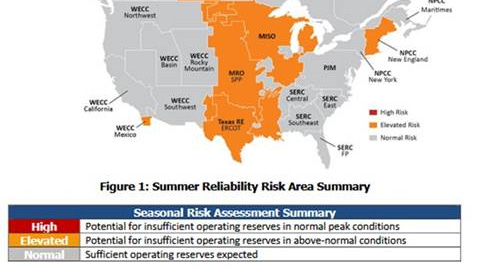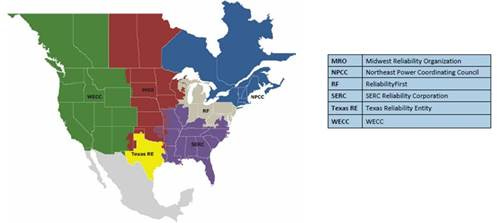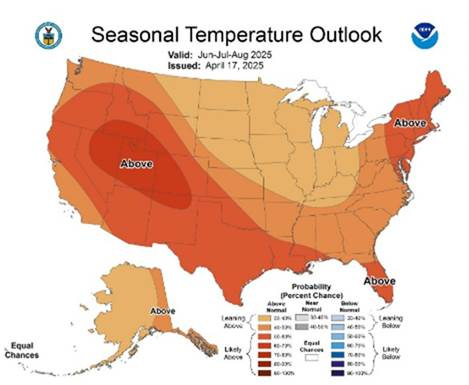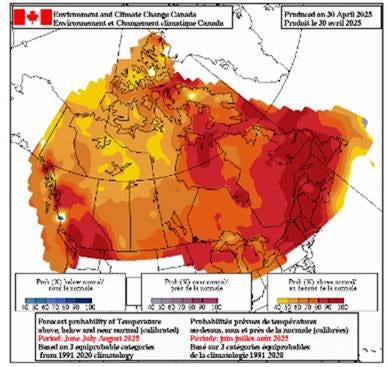Energy Musings - June 11, 2025
NERC's report on the vulnerability of grids this summer to abnormal weather targets the mid-continent and New England regions. Residents should prepare for blackouts and high bills.
Gambling With Your Electricity This Summer
The North American Electric Reliability Corporation (NERC) published its 2025 Summer Reliability Assessment in May. The organization routinely studies the expected reliability of regional electric grids during the summer and winter. The report received little notice outside traditional electricity and energy blogs and media. However, it contained a warning about potential brownouts and blackouts for several regions of North America.
NERC looks at electric grids in the U.S. and Canada, which is essential because numerous interconnections are key to ensuring energy supply for neighboring grids. Some 400 million people live in North America and depend on reliable power. The map and table show the six North American bulk power suppliers. The multicolor areas represent areas where the load-serving utilities participate in one regional entity while associated transmission owners and operators participate in another.
How NERC assesses North America’s energy market risk.
The NERC report shows the grids it assesses have troubling risks for brownouts and blackouts this summer. Most of the at-risk grids are in the central portion of North America, along with New England. There is also a tiny area of the western power grid in Mexico that NERC considers to be at risk of grid problems.
Here are the areas NERC highlights for power supply problems.
The table above shows that NERC classifies the grid risks as Elevated. That means there is the potential for insufficient operating reserves in “above-normal conditions.” How bad is the risk for these at-risk areas?
NERC has a table showing the operating power margins for each grid system in North America. The chart’s three columns show the results of NERC’s analysis of scenarios of on-peak seasonal reserve margin risks. One column lists the anticipated power margin percentage based on normal weather. The second lists the margin assuming typical supply outages. The final column shows the anticipated margin assuming higher demand, typical outages, and derates of generating capacity during extreme weather conditions. It is impossible to tell why the various regions identified at elevated risk were selected just from the numbers. It requires reading NERC’s analyses.
NERC’s summer grid supply risk assessment.
What NERC has done is to assess the elevated risk to grids due to supply shortfalls during periods of more extreme summer weather conditions. The elevated risk considers plausible scenarios, including 90/10 demand forecasts and historically high outage rates. The scenarios also assess low wind and solar supply conditions.
We are particularly interested in the NPCC - New England region, as we are currently at our summer home in Rhode Island. NERC says the Independent System Operator – New England (ISO-NE) could experience a low net margin of -1,473 megawatts (MW) after factoring in 1,245 MW of net interchange supply from neighboring grids. Capacity agreements support the interchange volume. ISO-NE has typically imported 3,000 MW of power during summer peak load conditions.
However, ISO-NE expects an additional 500 MW of forced outages from its generating fleet this summer. That will move it to institute operating procedures for mitigating that amount of lost power, which means rationing power. It may force interruptible users, often industrial customers, off the grid, or ask the public to shift its power use to different times of the day or to turn up air conditioning temperature settings. NERC foresees that ISO-NE may have cumulative loss of load expectations totaling up to 4.4 days this summer.
The weakness in NERC’s analysis is that it relies on normal weather conditions. Normal seldom happens. It is employing average weather conditions for the summer. The problem is that the National Oceanic and Atmospheric Administration (NOAA) recently released its seasonal temperature outlook for June, July, and August. Those three months represent the bulk of summer.
When we examine NOAA’s map of the country, which shows regions expected to have above or below normal temperatures compared to historical data, New England is one of three areas expected to experience above normal temperatures this summer. The areas projected to experience above normal temperatures include New England (ISO-NE), neighboring New York, and parts of Pennsylvania, New Jersey, Maryland, and Delaware. The grid in this region is one of the essential exporters of power to ISO-NE. The potential that this neighboring region experiences similar temperature extremes to New England could limit the amount of power available to be imported.
New England is forecasted to have above-normal temperatures.
Further complicating ISO-NE’s power supply situation is the outlook for the Maritime provinces of Canada, which are a significant power supplier to New England and New York. The Canadian weather service assigns this region some of the highest likelihoods of higher temperatures.
Canada is expected to be hotter than usual, reducing surplus electricity.
While NERC suggests that New England has an elevated risk of grid supply problems, the risk may be greater when all your neighbors who are power suppliers in normal times are experiencing similarly high temperatures. The entire area may not have enough power to meet the demand. That is a recipe for disaster.
Jim Robb, the CEO of NERC, told attendees at the Future Energy Forum in Washington last month, co-sponsored by the National Center for Energy Analytics of which we are a Senior Fellow, that “It’s easy to design things for the fat part of the curve – but power is most critical on the tails.” The scenario described above is such a “tail”, which is why its potential would be a disaster.
NERC’s analysis may signal New England residents should be wary of the region’s power supply this summer. NERC’s report may be providing a false sense of security. Some of that false sense of security comes from the assumption that solar and wind capacity additions will help to offset the increased supply risk.
We know, however, that as summer progresses, less solar power is available during the 4-6 p.m. timeframe when the region’s heat peaks. NERC also relies on the growing battery capacity being installed on the grid. Batteries are temporary power supplies, mainly limited to four hours. Heat waves tend to last for days, not hours. Batteries do not provide help for those extended periods. Similarly, heat waves tend to be accompanied by low levels of wind power, further eroding the assumed renewable energy supply.
Residents in New England and the other regions that NERC rates as having an elevated risk of power supply problems this summer should be prepared for brownouts and blackouts. Being prepared for a disaster that does not materialize may prove frustrating. But being prepared for when it happens will help you cope with the fallout.
Another problem the residents must prepare for is higher electricity bills. Given NOAA's temperature forecast, the Wall Street Journal warned Americans to prepare for higher electricity bills to keep cool this summer. It specifically warned New Englanders. “New England—where a dearth of gas pipelines keeps energy prices among the highest in the country—should see the biggest jump in monthly bills, up 6.7% from last year, to about $200.”
Blackouts are the most troubling problem. We have backup natural gas generators at our homes in Texas and Rhode Island. Last year, our Houston generator ran for 160 hours straight, generating electricity for our house in the aftermath of Hurricane Beryl that struck the upper Gulf Coast. We would have suffered for nearly seven days without power and our generator. Fortunately, we could provide refrigerator and freezer space to neighbors to help save some of their food. That is one example of the fallout from an extended loss of electricity. Hopefully, no one in the U.S. experiences an extended power outage this summer, but we aren’t relying on NERC’s analysis.








